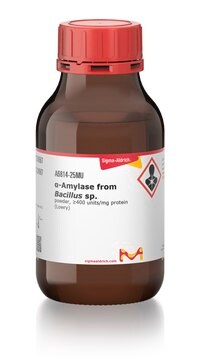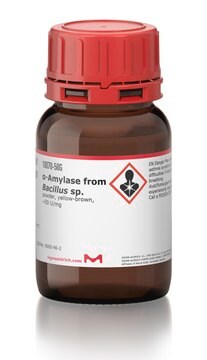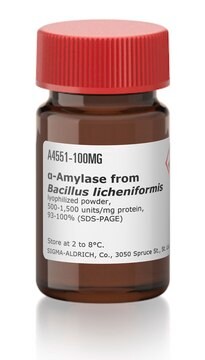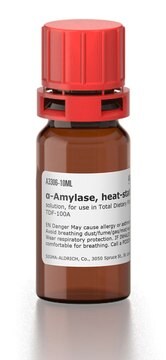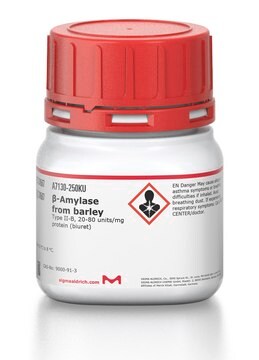A6380
α-Amylase from Bacillus sp.
Type II-A, lyophilized powder, ≥1,500 units/mg protein (biuret)
Sinonimo/i:
Alpha-Amylase, Glycogenase, 1,4-α-D-Glucan-glucanohydrolase
About This Item
Prodotti consigliati
Origine biologica
bacterial (Bacillus amyloliquefaciens)
Livello qualitativo
Tipo
Type II-A
Saggio
≥30%
Forma fisica
lyophilized powder
Attività specifica
≥1,500 units/mg protein (biuret)
PM
50-55 kDa by SDS-PAGE
tecniche
SDS-PAGE: suitable
Solubilità
H2O: soluble 0.1 mg/mL, clear, colorless
Compatibilità
suitable for hydrolysis, synthesis of oligosaccharides and polysaccharides, and sugar modification
applicazioni
life science and biopharma
Temperatura di conservazione
−20°C
Cerchi prodotti simili? Visita Guida al confronto tra prodotti
Descrizione generale
Applicazioni
- as a component of salivary fluid to perform artificial mastication; in luminal gastrointestinal digestion experiment
- as a standard in sodium dodecyl sulfate-polyacrylamide gel electrophoresis (SDS-PAGE) to determine the concentration of α-Amylase
- to de-starch the alcohol insoluble residue (AIR) for non-cellulosic neutral monosaccharide analysis
Azioni biochim/fisiol
Caratteristiche e vantaggi
- α-Amylase from Bacillus licheniformis NCIB 6346 retains over 98% of its activity after 60 minutes at pH 6.2 and 85°C.
- Other α-Amylase maintain 100% of their activity after storage for 1 hour at 91°C.
Definizione di unità
Nota sulla preparazione
Altre note
Substrato
Avvertenze
Danger
Indicazioni di pericolo
Consigli di prudenza
Classi di pericolo
Resp. Sens. 1
Codice della classe di stoccaggio
11 - Combustible Solids
Classe di pericolosità dell'acqua (WGK)
WGK 1
Punto d’infiammabilità (°F)
Not applicable
Punto d’infiammabilità (°C)
Not applicable
Dispositivi di protezione individuale
dust mask type N95 (US), Eyeshields, Faceshields, Gloves
Certificati d'analisi (COA)
Cerca il Certificati d'analisi (COA) digitando il numero di lotto/batch corrispondente. I numeri di lotto o di batch sono stampati sull'etichetta dei prodotti dopo la parola ‘Lotto’ o ‘Batch’.
Possiedi già questo prodotto?
I documenti relativi ai prodotti acquistati recentemente sono disponibili nell’Archivio dei documenti.
I clienti hanno visto anche
Il team dei nostri ricercatori vanta grande esperienza in tutte le aree della ricerca quali Life Science, scienza dei materiali, sintesi chimica, cromatografia, discipline analitiche, ecc..
Contatta l'Assistenza Tecnica.